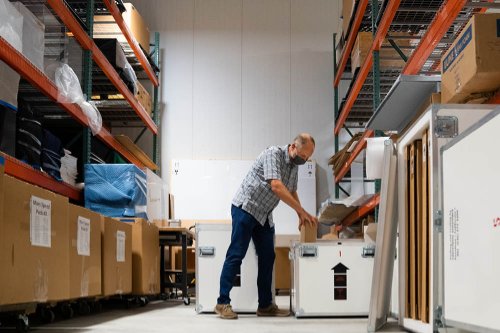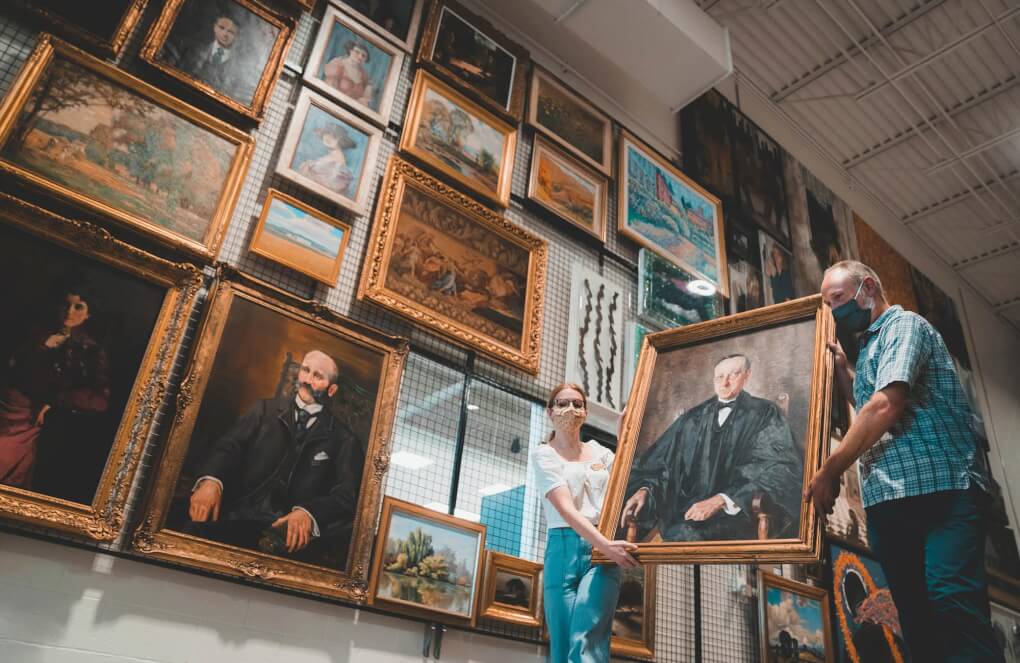This is the story of an immigrant who settled in West
Michigan, who contended with rapid and immense societal change, who
withstood the isolation of a pandemic and who, while influenced by
world travels, celebrated the beauty in his local surroundings.
It is a story told through a paintbrush as the 20th century dawned,
by a German-born artist who always stayed true to himself by painting
the world his way, in the way he saw it.
When Mathias Alten saw modernization, he favored depicting nostalgic
rural scenes. When he experienced the isolation of the 1918 pandemic,
he looked within, resulting in a notable number of self-portraits
during that era. When he traveled domestically and internationally, he
often painted with a burst of inspired creativity.
But no matter the inspiration from international travels, which
included many major artistic and cultural centers, he always came back
to Michigan.
“Alten painted the landscape of Michigan throughout his entire career
from different perspectives,” said Nathan Kemler, director of Grand
Valley’s galleries and collections. “He painted the lakeshore, the
cities and the rural areas.”

Joel Zwart, curator of exhibitions for the Art Gallery, moves artwork
for the exhibition.
Kemler said these environmental landscapes were what initially spoke
to George Gordon, who along with his wife, Barbara, donated 35
paintings in 1998 to initiate Grand Valley’s collection of the
impressionist artist referred to as the Dean of Michigan painters.
The momentum that ensued after that initial donation, and with
continued support, has led to Grand Valley holding not only the
world’s largest public collection of the artist’s work but also the
entire artist Catalogue Raisonné and published scholarship.
“All of this is only possible because of the Gordons’ contributions
and their passion not only for Mathias Alten but also art in general,”
Kemler said. “The Gordons could have done several different things
with that collection. They shared our vision that works need to be
seen, they need to be shared and they need to be out in front as much
as possible, not in storage.”
That is why it is appropriate that on the occasion of the 150th
anniversary of Alten’s birth in 1871, the Art Gallery is sharing his
enduring legacy throughout the state in a traveling exhibition.
Preparing the pieces for the traveling exhibition involved meticulous work.
Telling Alten’s Story Statewide
The first stop for the exhibition, “Mathias J. Alten: An American
Artist at the Turn of the Century,” was the Dennos Museum Center in
Traverse City. Other scheduled venues are the Daughtrey Gallery at
Hillsdale College, the Michigan Historical Museum in Lansing and the
Muskegon Museum of Art, said Joel Zwart, curator of exhibitions for
the Art Gallery, who added officials are working through hosting dates
due to the uncertainty from COVID-19.
The exhibition includes more than 40 works drawn from the Art Gallery
collection, historical photos and personal artifacts such as brushes
to fully tell the story of Alten’s life, Zwart said.
“In some ways, we see this exhibition as a gift to the state of
Michigan,” Zwart said.
Said Kemler: “Narratives of empathy, peace, love, social justice,
equity — all core elements to what it means to be human — are told
through art. I believe the stories art tells belong to everybody, and
we want to take these stories into our communities and across our state.”
One artist’s take on change
Alten’s story is in many ways a timeless one of someone trying to
make sense of change, Kemler said. In Alten’s time, he witnessed rapid
advances in transportation, industry, agricultural machinery and more.
“While he was living with it in his every day, he decided to paint
what was happening before these great changes,” Kemler said. “Everyone
embraces change differently.”
Alten would use artistic license to hide modernization, Kemler said.
If Alten was painting a landscape dominated by a smokestack, he would
omit it. Kemler also noted that of the approximately 3,000 works Alten
created, only one contained the image of a car.
Alten showed a particular affinity for painting agricultural scenes
showing oxen, horses or more traditional equipment, Kemler said. Alten
would even depict these operations from what he saw while traveling
internationally to such places as the Netherlands or Spain, but many
of the prevalent scenes were from Michigan.
In fact, Alten would use modern transportation such as the electric
interurban to travel to Ottawa County farmlands to paint these favored
scenarios, said Matthew Daley, associate professor of history and an
expert on West Michigan history. Many farmers in that area had small
operations and it made sense to continue with traditional agricultural
methods such as animal power.
Daley incorporates Alten into his coursework on local history as well
as urban and industrial history. While some art of that era glorified
industry, Daley said Alten’s general shunning of modernization
provides an important counterpoint for students as they study
industrialization and how it affected Grand Rapids.
“I want students to think of other depictions of Grand Rapids, the
industrial life, and the different representations of West Michigan
especially during his lifetime and that transformation,” Daley said.
“Alten did a number of works depicting Grand Rapids with his style,
and he presents a particular image of the city, always with a focus on
the river.”
Daley has taken his students to the George and Barbara Gordon Gallery
on the Pew Grand Rapids Campus and has enjoyed watching them reflect
on what they saw in paintings when they then go out into the city.
He said a number of students find they connect with Alten’s more
straightforward artistic style. Kemler noted Alten’s work is more
subtle as opposed to hitting viewers with emotion, inviting them to
slow down and reflect.

The gallery named for George and Barbara Gordon, whose initial
donation set Grand Valley on course to hold the world’s largest public
collection of Mathias Alten paintings.
Lasting Impact
Since that initial donation more than 20 years ago, the collection
has grown well beyond initial expectations, Kemler said. It includes
120 works in two dedicated galleries as well as three different
dedicated endowment funds set up around Alten.
The gallery is generally open for free every Friday and Saturday,
which matches Grand Valley’s mission of offering a borderless,
barrier-free gallery. Kemler is envisioning ways to continue to tell
Alten’s story and highlight the nuances, helping us see ourselves.
The impact from the faith that the Gordons put in Grand Valley to be
stewards of these works, part of the third-largest art collection in
the state, was both immediate and long-lasting, Kemler said.
“The magnitude of the Alten collection is that it is a premier
collection that initially put Grand Valley on the art map,” Kemler
said. “Alten is one of the most important painters in the history of
Michigan and is a known painter across the country, and we have been
able to raise awareness about him through Grand Valley, giving him
higher visibility.”

Mathias J. Alten, Hauling the Boulder, 1910, oil on canvas.
GVSU Art Gallery, Gift of George H. and Barbara Gordon (2016.65.1)
Over his career, Alten returned to paint scenes that combined manual
labor and the rural Michigan landscape. This piece illustrates Alten’s
commitment to that subject matter. In it, we see a farmer bending down
to connect a boulder to his team of horses, whose breath is visible in
the cold air. Above them, the sun begins to break through dark clouds,
illuminating and warming this agrarian landscape.

Mathias J. Alten, Oxen, Boat and Fishermen, Valencia, 1912,
oil on canvas. GVSU Art Gallery, Gift of George H. and Barbara
Gordon (2018.66.1)
Alten’s visits to Spain had a profound effect on his work, and
contributed to the lightening of his palette. As in his experience in
the Netherlands and other locations, Alten sought out environments
with traditional laborers and nostalgic settings. Here we see
traditional Spanish sardine fishermen using oxen to pull their boats
onshore near Cabañal.

Mathias J. Alten, Self Portrait, Myself at 66, 1937, oil on
canvas. GVSU Art Gallery, Gift of George H. and Barbara Gordon (2009.90.1)
This piece from 1937 is the last known self-portrait he completed, as
he passed away the following year from a heart attack.
Self-portraiture was something Alten returned to on a number of
occasions in his lifetime, including the period during WWI and the
1918 flu pandemic when he painted quite a few from the confines of his
studio (albeit more formal than this one).

Mathias J. Alten, Picnic at Macatawa, 1904, oil on canvas.
GVSU Art Gallery, Gift of George H. and Barbara Gordon (1998.580.1)
This is a quintessential West Michigan scene. Alten painted many
landscapes around the interior of the state of Michigan during his
lifetime, and also spent time along the lakeshore. Here we see the sun
slowly sinking amidst clouds over Lake Michigan, casting pink, orange,
yellow and purple throughout the composition.

Mathias J. Alten, Picnic at Macatawa, 1904, oil on canvas.
GVSU Art Gallery, Gift of George H. and Barbara Gordon (1998.580.1)
Finally, this earlier work by Alten is an autobiographical account of
his family enjoying a picnic in the dunes near Holland, Michigan. By
the start of the 20th century, recreational activities became
increasingly accessible to the middle and working classes. Residents
of Grand Rapids, such as the Altens, would take the electric
interurban to the lakeshore to enjoy time away from work and the city.
This wonderfully intimate scene also illustrates the influence of
Impressionism on Alten. Using visible brush strokes, Alten emphasizes
the changing qualities of light as it is filtered through the trees.

















